Archives
- 2011/09/22Day 32 of shooting
- 2011/09/21Day 31 of shooting
- 2011/09/20Day 30 of shooting
- 2011/09/08Day 29 of shooting
- 2011/09/07Day 28 of shooting
- 2011/09/06Day 27 of shooting
- 2011/09/05Day 26 of shooting
- 2011/09/04Day 25 of shooting
- 2011/09/03Day 24 of shooting
- 2011/09/02Day 23 of shooting
- 2011/09/01Day 22 of shooting
- 2011/08/30Day 21 of shooting
- 2011/08/29Day 20 of shooting
- 2011/08/28Day 19 of shooting
- 2011/08/27Day 18 of shooting
- 2011/08/26Day 17 of shooting
- 2011/08/25Break in the shooting
- 2011/08/24Day 16 of shooting
- 2011/08/23Day 15 of shooting
- 2011/08/22Day 14 of shooting
- 2011/08/21Day 13 of shooting
- 2011/08/20Day 12 of shooting
- 2011/08/19Day 11 of shooting
- 2011/08/18Day 10 of shooting
- 2011/08/17Day 9 of shooting
- 2011/08/16Day 8 of shooting
- 2011/08/15Day 7 of shooting
- 2011/08/14Break in the shooting
- 2011/08/13Day 6 of shooting
- 2011/08/12Day 5 of shooting
- 2011/08/11Day 4 of shooting
- 2011/08/10Day 3 of shooting
- 2011/08/09Day 2 of shooting
- 2011/08/08The 1st day of shooting
- 2011/08/04All staff meeting
The basis for what would become the live action film Jellyfish Eyes was developed after I first opened an animation studio in Daikan Yama. The project was to be the studio’s modus operandi, a feature film animation. The idea developed from conversations I had at the time with a cactus breeder who lived in the Saitama town of Okuji, near Yori, the last station on the Tobu Tojo line.
This breeder’s main living was made as an insurance salesman. It turns out that there are a lot of Brazilian laborers who live in Gunma Prefecture and most of them are without Japanese health insurance. My aquaintance saw this as a business opportunty and so he began to customize Japanese plans and convince the workers that they would be better off insured. It was a huge hit. “I have a knack for sales” he would tell me. In fact, he even built up a bubble in cactus sales, and to these foreign laborers, he seemed like an enlightened, rich man. It was a rather sad sight.
Having myself lived abroad in New York for two years, I well understood their predicament – the daily unease of being a stranger with seemingly no place to go. As you encounter the endless stream of absurdities that greet people in these situations, you eventually begin to wonder “Why am I going to all this effort to live heere anyway?” For me, it was the desire to escape the Japanese art scene that prevented from going home. Whatever the case, I shared some similarities with these workers who had left their country to earn money and felt a deep amount of sympathy for them.
And that’s when my imagination began to go to work:
・Gunma
・An encounter between Brazilian and Japanese children
・A paranormal phenomenon that links them together
・A final scene where the protagonist returns to Brazil
I laid out a scenario that had all these aspects.
From there, I began to develop images for the characters and before long, I had a complete skeleton! In order to flesh out the aesthetic aspects of the world I’d created, I used the project as a motif for several paintings and sculptures which were shown in a solo exhibition. “I’m ready,” I thought happily. “I’m going to make an animated film.” And it was then that I formed the animation studio. From there, however, I was unable to thread together the story.
I thought that if I continued to list-up my ideas, that eventually the story would follow and so I struggled through two long years, but in the end, we were never able to finish anything more than a handful of short pilots. The project had gone off the rails, seperating into several divergent works. I had, to tell you the truth, given up. But now, I’ve begun a second moment in the sun and this time, I’m praying that I will be able to follow things through to the end. Do you hear me movie gods?!

Art staff Tetsuya Nomura. He’s busy building something on set.
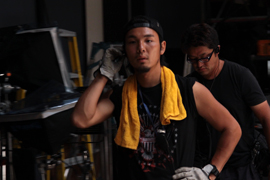
Lighting assistant Yoshitsugu Ochiai (AKA Ochi).
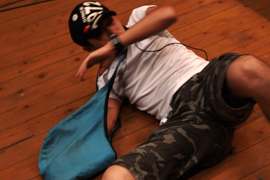
Second Assistant Director Toyohiro Miyata giving some fairly vivid instructions to the actors.

Stylist Kazuki Yunoki’s unit. From left: Manami Ohsumi and Tsuneo Tada. When all of the costumes for the entire cast are put together, it’s a pretty impressive amount.
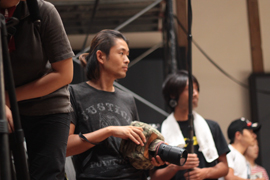
Still cameraman Taka Koike. The hood over his camera muffles the sound of the shutter so that it can be used on set. He made it himself.
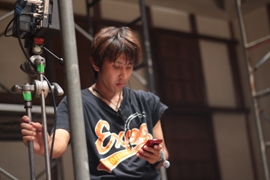
Makoto Miki from Cinematographer Yasutaka Nagano’s team. Our still and movie photographers have combined to form one 6-man unit.
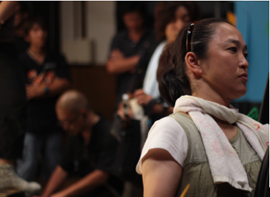
Our crew is composed of members who had previously worked on Yoshihiro Nishimura’s Helldriver. As such, they have a bond formed in the heat of battle on what was allegedly a nightmare of a shoot. “During Helldora (the abbreviated nickname for Helldriver), we never slept a wink and it was raining throughout the entire shoot. It was awful. A once-in-a-liftetime experience,” she tells me.
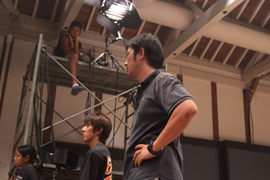
In the front center of this photo is Action Instructor Arata Yamanaka from ZERO’S.

Cast member in a skin tight green suit.
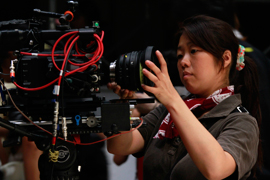
Yasutaka Nagano’s right hand Mami Shimoda. After she’s finihed focusing, she’ll turn to overseeing the camera’s every movement.